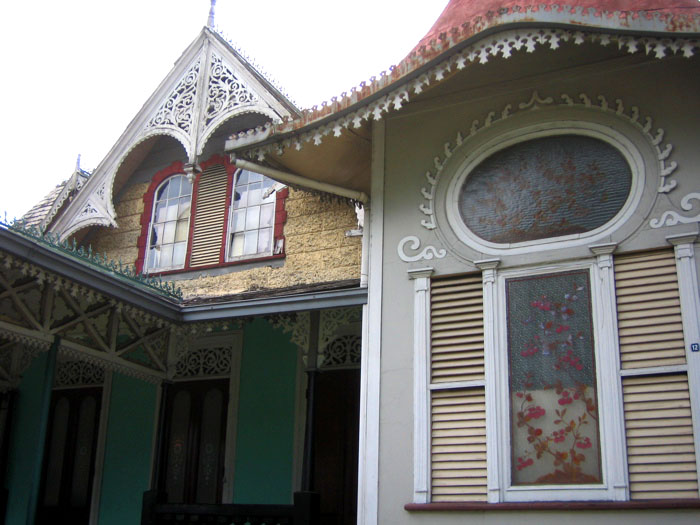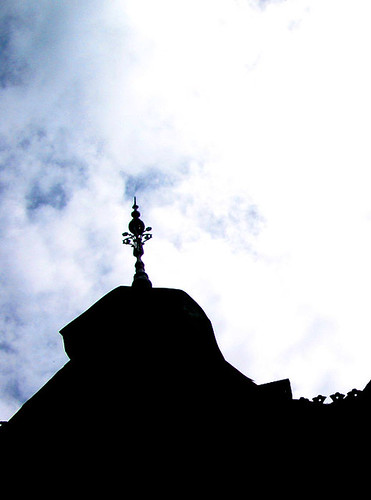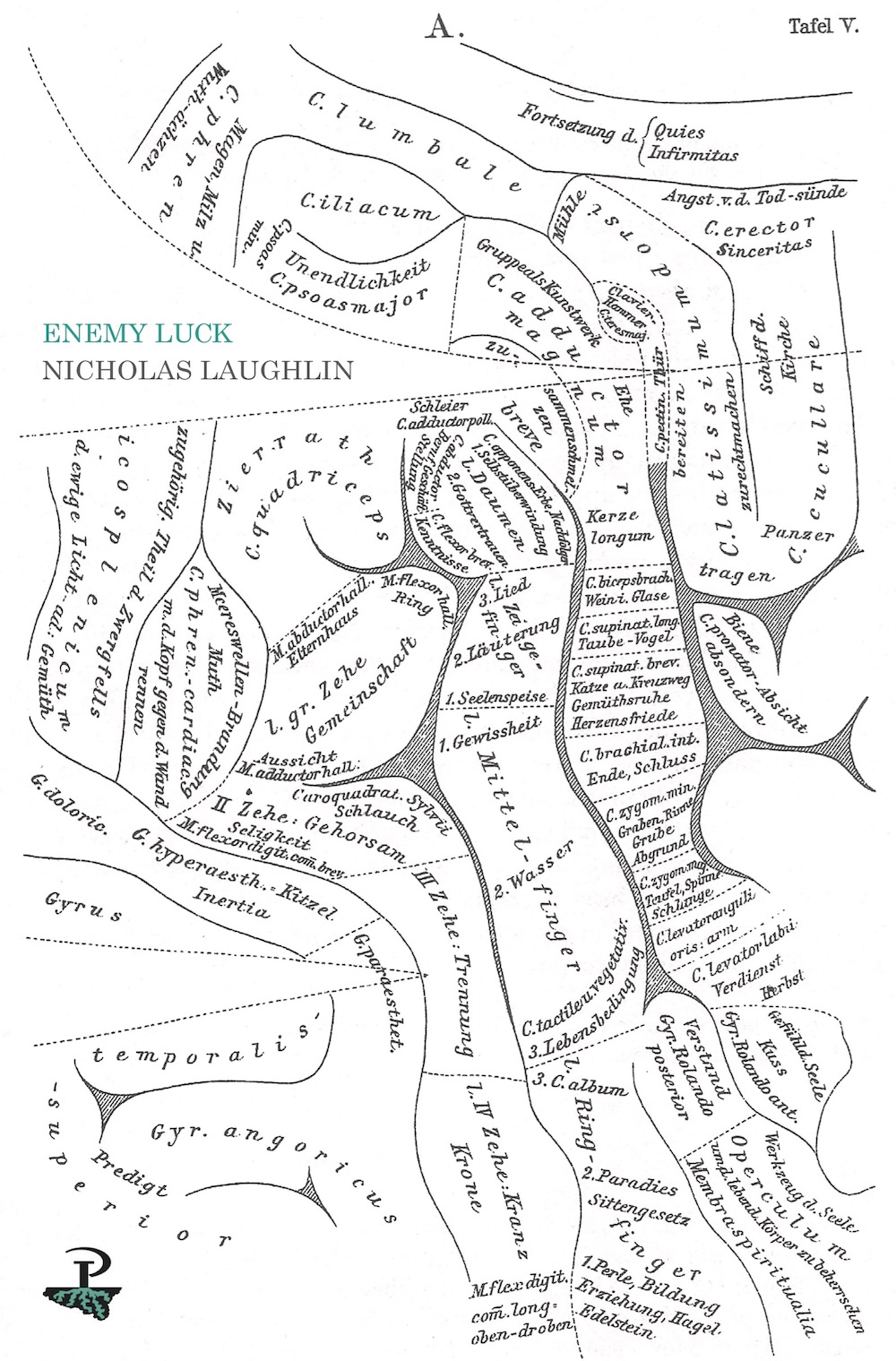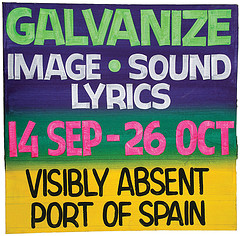
Detail of the front facade of the Boissiere House at 12 Queen's Park West. Note the ornate fretwork of the main gable to the left, and the detailing, including painted glass windows, of the "Chinese pavilion" study to the right.
There are so many things to be anxious or angry about in this country these days--crime, corruption, smelters, steel mills, dolphin-slaughter, traffic--that the fate of an old house may seem trivial.
But 12 Queen's Park West, the Boissiere House, is not just an old house. It is a gorgeous example of the late Victorian gingerbread style that was once typical of Port of Spain. It is a major city landmark, familiar to tens--even hundreds--of thousands, and known to many simply as "the Gingerbread House". It is the ultimate creole house, part Amerindian ajoupa, part French chateau, part Chinese pagoda, built with the sweat and labour of forgotten ancestors. It is a national architectural treasure:
It is also, I am afraid, in peril.
Why? Because after remaining in the Boissiere family for 104 years, since it was built in 1904, it is now being offered for sale, at a price of TT$50 million. Any private buyer willing to pay that will almost certainly bulldoze it and build an office block or posh condominiums to recoup their investment.
We've seen this happen so many times before. Just in recent years we've lost the Lee House on St. Clair Avenue, Bagshot House in Maraval, the Union Club on Independence Square, Coblentz House in St. Ann's, and numerous smaller gingerbread houses all over the city. Just a couple months ago, the big orange Pierre house on the Roxy roundabout disappeared, after years of neglect. The Trestrail Building on Broadway, with its cool, understated Corinthian columns, was bulldozed to build another yet office tower.
The architect Edward Bowen designed the Boissiere House with its ornate fretwork -- described 25 years ago by John Newel Lewis as "the finest remaining example in Trinidad" -- its study in the form of a tiny Chinese pavilion, its painted glass windows, and its gesso-work ceilings. It is Bowen's masterpiece, and one of the dozen or so most important buildings in Port of Spain, in the same league as the Magnificant Seven, Knowsley, the Red House, the two cathedrals, and the Cabildo. Though the house and land on Queen's Park West are the property of a private owner, it is also, surely, after 104 years, part of our common heritage.
But with all those other things to be anxious or angry about, all the ills and inequalities of our society, is it really worth getting upset about losing the Boissiere House? I think it is. Because this is a line in the sand, a test of how mercenary and philistine we really have become. Contemporary Trinidad seems hell-bent on destroying everything we have that is beautiful and authentic, usually in the name of the dollar. We knock down gorgeous old buildings, erase their history and stories and memories, and build air-conditioned Miami-boxes. We pave our green open spaces. We drown true mas in floods of sequinned bikinis imported from China. The works of art in our National Museum are literally crumbling from neglect (when last did you go and look at them?). Most of our musicians can't get airplay (when last did you hear jointpop on the radio?). At some point will we say, enough is enough?
Could this be that point?
So what might we do? There seems to be only one realistic option: persuade our government that the Boissiere House is a crucial and irreplaceable part of our national heritage, that it must be bought by the state, restored, and put to appropriate public use.
$50 million is a lot of money. But we can afford to build skyscrapers--ugly ones--and prime ministerial palaces, and buy droning blimps, and build white elephant cricket stadiums, and our prime minister can afford to hire a crack team of private security agents. We have, frankly, more money than we know what to do with.
Can we afford to save this one, beautiful old house--just because it is beautiful, because it makes our increasingly ugly city a little easier to live in? Because it brings a moment of pleasure to everyone jogging round the Savannah or stuck in traffic on Queen's Park West? Because it represents our history, and our collective memory, and that is something no one can put a price on?
I am going to do all I can. Other concerned citizens are already working quietly to save the Boissiere House. I think it's time to stop being quiet. If you want to help, here are some simple, practical suggestions:
- Tell people the Boissiere House is in danger.
- Forward this blog post to everyone you know who might be concerned.
- If you have a blog, write your own post there, or link to this.
- Write a letter to the editor.
- If you work in the media, try to get your newspaper or station to run a story.
- If you own a camera, stop by 12 Queen's Park West, take some photos, post them online, or just forward them to friends. Here are mine.
- If you know someone in the Ministry of Culture, tell them you're concerned and ask them to speak to their superior about saving the Boissiere House.
- Call Town and Country and urge them not to give planning permission for a new building on this site.
- Call the National Trust and ask what you can do to help.
- If you know a politician of any party on any level, tell them you're concerned and ask them to talk to their party leadership.
- Read about the history of the house in Olga Mavrogordato's book Voices in the Street, or John Newel Lewis's book Ajoupa, and share this with others.
- Come to the event we're planning at Alice Yard next week Friday to discuss why this and other historic buildings are worth preserving.
- Email me (my address is in the sidebar to the right) and tell me you'd like to be on a mailing list to hear about further efforts. A website is on its way, also an online petition.
- If you know a member of the Boissiere family that owns the house, ask them to consider putting a no-demolition clause in the sale contract, or to negotiate with the government to arrive at a reasonable sale price that might make it easier to save the building.
- And if you are a multi-millionaire property developer, consider doing something truly enlightened: buy the house, pay to have it restored, put it to some use that will not damage its fabric.
Finally: ask yourself if you'd be willing to stand in the hot sun with a placard, if it comes to that.

Detail of the painted glass windows in the study of the Boissiere House.

The iron finial on the roof of the "Chinese pavilion".









9 comments:
In 1969 at carnival time, I was pregnant with my daughter who is now going on 39 years, a fight broke out just outside the Bossiere house and my mother was with us and she new the ladies who lived there so she took me into the house for safety,they welcomed us and she has along ls talk with her long lost friends. so I think the house should stay in that palce.
It this not a privately owned home?
The family ultimately are the one's to decide.
It is a nice house, like many who have fallen prey to 'progress' and a fat wallet.
But if the family see it as a sound investment and we do not have any policy ( which should have been in place since the Roxy situation)
I see it in the hands of the people who are most affected
-The owners.
Why not ask them not to sell of offer an alternative?
50 million, 16 million, 5.5 million, I have been hearing so many different prices...
A Museum at the end if it all? ...well ...who's?
why not a health centre that's where money is needed....
..It is a nice hosue but I really don't know what it stood for besides its sturdy foundation and stain glass windows.
Maybe some things are left to memory
But good luck and all the best.
A simular situation happend where I lived but it was 'beyond the lighthouse' so I don't think anyone took notice of the emails.
O'
Nicholas, do you know if there are photos of the Lee House, Bagshot House, the Union Club, Coblentz House in St. Ann's, and the Pierre house on the Roxy roundabout? I was really shocked to see the last one go with no hue and cry...
I remember that house walking from school to my grandparents home in St James.I always wished I could wive in that house,maybe if the owners were less fortunate they might appricate what they have and save it for the generations to c
cometo be see what their ansestors built and the beauty and craftmanship in the building.
I'm thinking of burning it down myself...seriously
The more I hear about it I am thinking - who's heritage? Mines? Hell no...the people in that house have their own exclusive club ...The house never contributed to anything in society except dinners and tea after church for wrinkled old people.
So although it is a nice house...to be honest it has nothing beyond that.
maybe they should just transplant the stain glass to another location.
Let's get back to griping about crime.
Dear Anonymous,
Thanks for joining in the conversation. I disagree with you, of course, and I'm sorry you feel that the house at 12 Queen's Park West is not part of your own heritage. (Sorry also that you didn't feel comfortable enough to sign your note with your name.)
But you raise an important question about the social value of cultural preservation. Protecting old houses--along with funding art galleries etc.--is often seen as a preoccupation of the social elite. It shouldn't be.
The Boissiere House obviously must have a special emotional resonance for the family who lived in it, the friends who visited them there, etc. But its fabric of memories includes the stories of the domestic workers who ran the house for so many decades--their lives and work are partly recorded in the layout of the rooms and outbuildings, which are remarkably intact. The house was built by many anonymous craftsmen--masons, carpenters, the woodworkers who created the beautiful fretwork, the iron-workers who made the railings and finials. It is their masterwork as much as the architect's, and we ought to preserve the house for their sake also. The original owner of the house, C.E.H. Boissiere, was a businessman who lent small sums of money to working-class people who could not get bank loans. He ran that business--which I would argue did contribute something to society--from the front study of his house. This is all apart from the fact that the house has given aesthetic pleasure to many thousands of people over four generations, and will continue to do so for generations more if we act now to protect it.
You mention "griping about crime". I'd ask you to consider this: could there be a connection between a city planned for both efficiency and aesthetic pleasingness--a city that is pleasing to live in, work in, move about in--and a heightened sense of civic responsibility on the part of its citizens? Because that very sense of civic responsibility, or the devastating absence of it, is behind most of the problems faced by contemporary Trinidad and Tobago. And I for one am tired of griping. The Boissiere House campaign has as its immediate goal the preservation of one old house, yes. But we are also trying to start a real conversation about how our city and our country are changing, whether those changes are good or bad ones, and what is the true meaning of development.
Even more valuably, this campaign is an object lesson in how concerned citizens can motivate and mobilise themselves to achieve things that benefit us all, even against dismal odds.
Perhaps I haven't managed to change your mind here. In that case, assuming you live in Trinidad, I encourage you to come to the "Preserving the Future" event at Alice Yard this Friday night. Make your arguments, listen to the arguments of others, and let's see what we can learn from each other. Here are details of the event:
http://aliceyard.blogspot.com/2008/02/preserving-future-conversation-about.html
Nicholas Laughlin
I think the viewpoint of 'anonymous' is far more relevant than whether he/she chooses to sign his/her name.
Generations after that house was built, the sociocultural divisions of the society remain. I am afraid that after reading Mr. Laughlin's response, however reasoned that response attempted to be, it doesn't seem that the author really fathoms the mind-set of the majority of Trinidadians. Even worse, I don't think Mr. Laughlin even addressed the important point of the autonomy of the current owners of the house, as indicated by Red. The scenario reminds me of an analogy: a doctor needing to cut off a patient's leg to save the patient's life, but the patient says, "no". The doctor then proceeds to ignore the patient's wishes, and cuts the leg off anyway. The doctor knows best, yes? Unfortunately, by ignoring a patient's wishes, the doctor has contrived, in his 'wisdom', to breach a sacred ethical, and moral code. The patient's life may be saved, but the harm done is catastrophic.
Speak to the owners, if possible, make your point, beg, grovel, but at the end of it all, the decision is theirs, and you should respect it. That will take us a farther way down the road to civilization than a house saved through a war of attrition amongst ourselves.
It is amazing to me to read the posts to this blog. Several people miss the point, because they fail to see the forest for the trees. If the city of Port of Spain continues to change the way it is now, you will end up with Las Vegas or Miami or any other non descript "modern" city. Concrete and glass boxes built to maximize the square footage and cost thereof. Thoses of you who have traveled outside the island to cities in Europe and the N.E. United States will understand why its important to preserve as well as built new. Without a blend of Architecture (past and "future") the word bland with take on new meaning. Trinidadians are many things in this life but "bland" has never been one of them..make sure it does not happen....save the damn house...shimps man
I enjoy what I am reading here and commend everyone for taking the time to participate.
How our cities develop is so important. Yes there is the issue of local identity and avoiding homogeneity. Moreover, cities liek Chicago, Toronto, New York are looking for ways to build that are easier on the planet - energy efficiency , choice of construction materials , disposal of materials. What model of 'city' are we following? The old ideas of the city or can we join the new movement. We can choose not to - the whole of POS will be under water so it won't matter in any case - I live on a hill in Sando.
Post a Comment